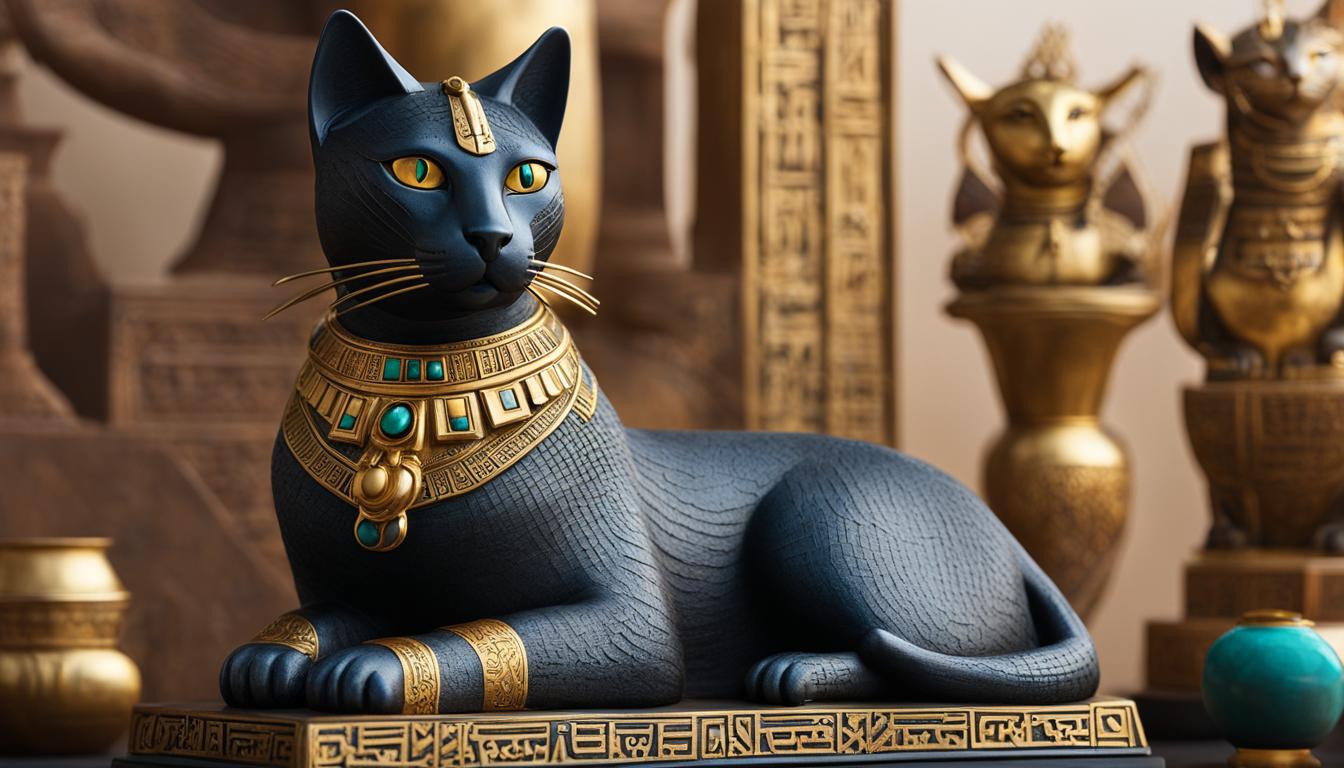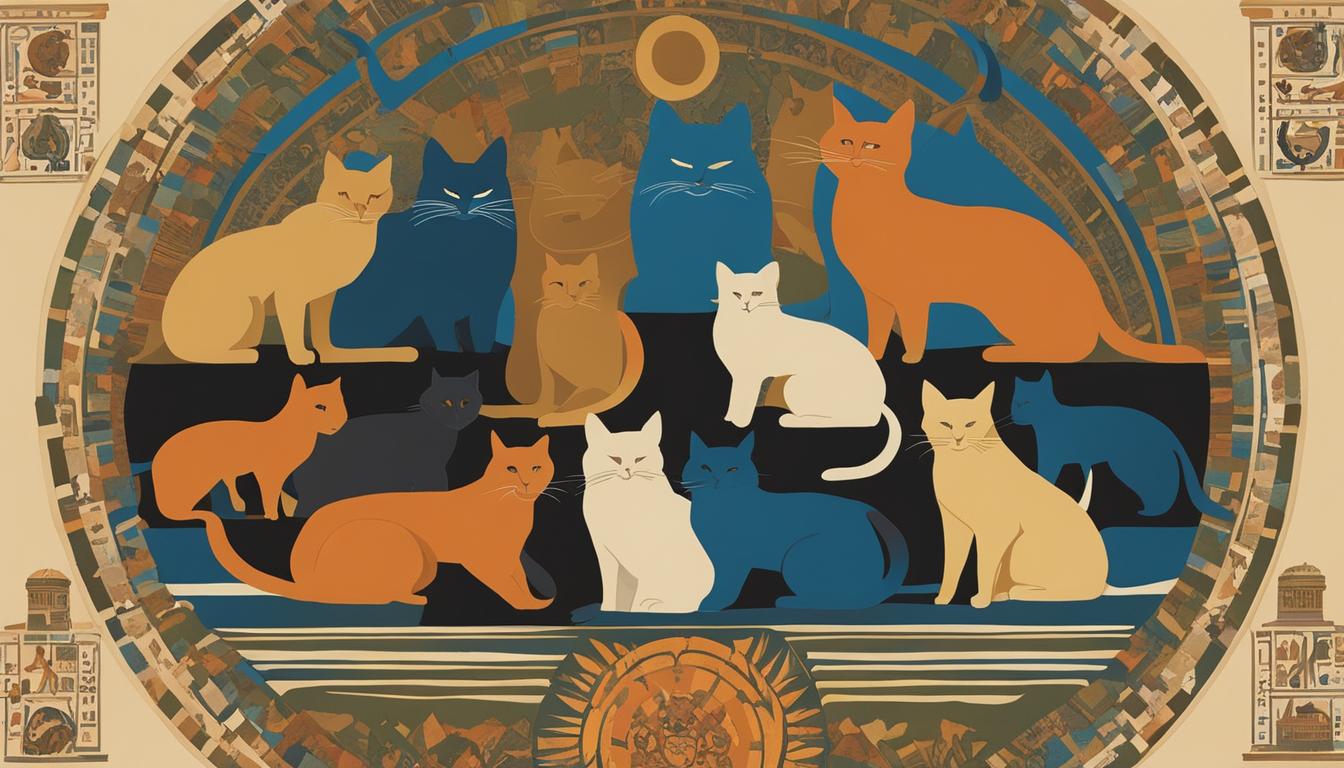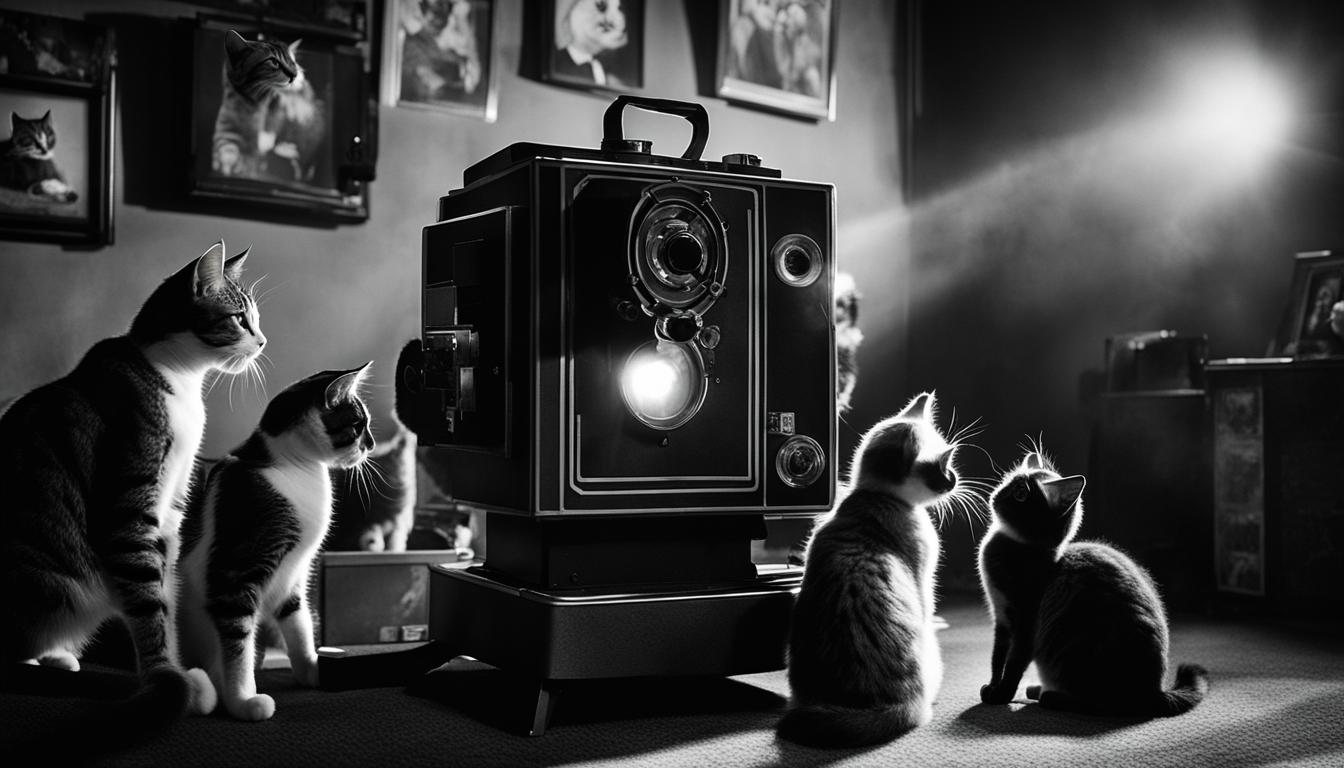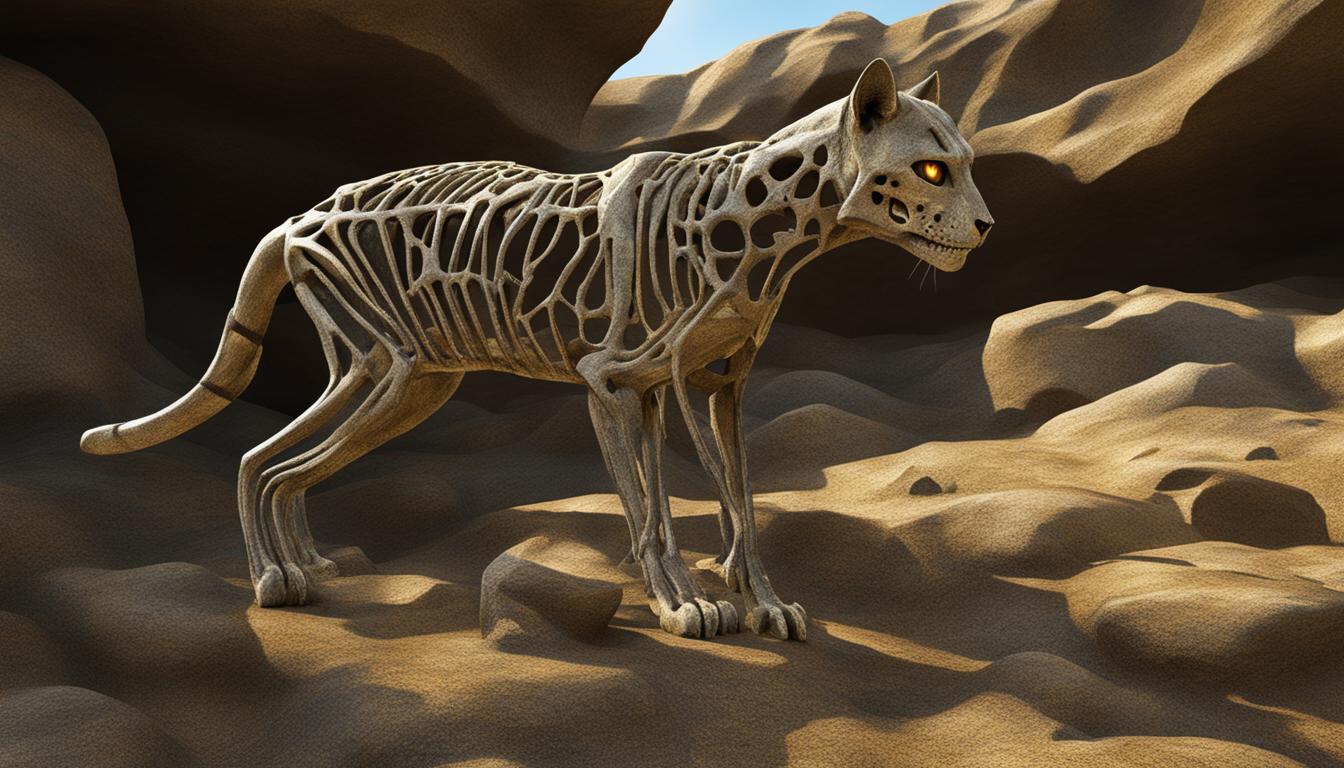Curiosity, mystery, and elegance. These are just a few words that come to mind when I think about cats. But did you know that the fascination with these enigmatic creatures dates back to ancient civilizations? In this article, we’ll explore the captivating world of cats in ancient art, from Egyptian tombs to Greek and Roman sculptures.
When we delve into the depths of history, we uncover a treasure trove of ancient cat art and artifacts. These captivating depictions offer a glimpse into the significance and reverence that felines held in different cultures. So, let’s embark on a journey through time and discover the mesmerizing artistic representations of cats in ancient civilizations.
Key Takeaways:
- Cats played a significant role in the art of ancient civilizations.
- Egyptian art showcased cats as sacred animals associated with goddesses like Bastet.
- Greek and Roman art depicted cats, though not as prominently as Egyptian art.
- Cats continued to be depicted in medieval tapestries, reflecting their importance in daily life.
- Cats have been art subjects in various cultures, spanning from prehistoric cave paintings to modern-day artworks.
Cats in Egyptian Art
Ancient Egyptian art is renowned for its beautiful and intricate depictions of various aspects of life, including the important role of cats in their society. These feline creatures held a special place in the hearts and minds of ancient Egyptians, often being regarded as sacred animals. As a result, cats found their way into many artistic representations, such as tomb paintings and sculptures.
The ancient Egyptians associated cats with the goddess Bastet, who was often portrayed as a lioness or as a woman with the head of a lioness. Bastet was the goddess of home, fertility, and protection, and cats were seen as her loyal companions and guardians. Therefore, it is not surprising to find numerous depictions of cats in Egyptian art, symbolizing their reverence for these animals and their deep belief in their divine qualities.
One of the most iconic examples of cat depictions in Egyptian art is the bronze statue of Bastet in the form of a seated cat. This statue, now housed in the British Museum, showcases the elegance and gracefulness of cats that the ancient Egyptians sought to capture. The intricate details of the statue, such as the perfectly sculpted facial features and the ornate collar around the cat’s neck, highlight the craftsmanship and artistic skill of the period.
| Cat Depictions in Egyptian Art | Description |
|---|---|
| Tomb Paintings | Many tombs in ancient Egypt were adorned with colorful paintings depicting scenes from daily life, including the presence of cats. These paintings showcased the close relationship between humans and cats, illustrating their companionship and the roles they played in households. |
| Sculptures | Egyptian sculptures often featured cat figures, both large and small. These sculptures were crafted with meticulous detail, showcasing the beauty and grace of cats. Some sculptures were even made as offerings to the gods, symbolizing the eternal presence of cats in the spiritual realm. |
“Cats were highly regarded in ancient Egyptian society and were often mummified and buried with their owners. The importance of cats in their culture is evident in the abundance of cat art and artifacts found throughout Egypt.”
Overall, the artistic depictions of cats in Egyptian art provide valuable insights into the cultural significance and reverence for these animals. They showcase the deep connection between the ancient Egyptians and cats, serving as a testament to the special place these enigmatic creatures held in their society.
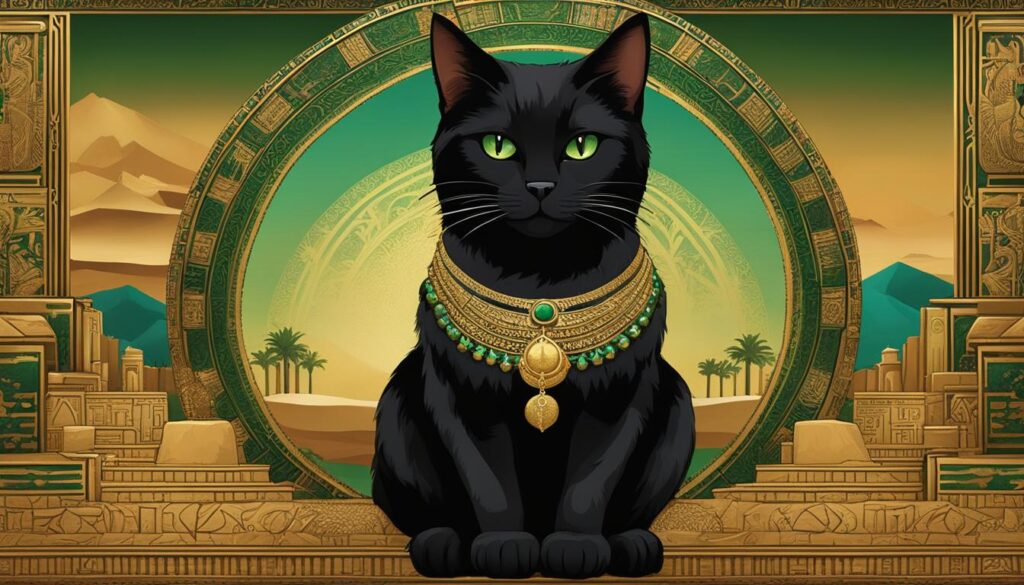
Cats in Greek and Roman Art
While cats held a prominent place in the art of ancient Egypt, their presence in the artistic depictions of ancient Greece and Rome was not as widespread. Nonetheless, cats made appearances in various forms of art, particularly in sculptures and mosaics. These artistic representations of cats provide valuable insights into how they were perceived and interpreted in these civilizations.
The Interpretation of Cat Art in History
In ancient Greek and Roman art, cats were often depicted in a more nuanced manner than in Egyptian art. They were not solely regarded as divine beings but were associated with specific traits and symbolism. Cats were commonly associated with cunningness and intelligence, reflecting their reputation as skilled hunters and survivors. They were also perceived to possess protective qualities, guarding against evil spirits and bringing good fortune.
These artistic representations of cats in Greek and Roman art showcase the cultural significance and diverse interpretations of these enigmatic creatures. They serve as a testament to the fascination and admiration that cats have evoked throughout history.
The depiction of cats in ancient sculptures was particularly notable. Cats were often portrayed in a naturalistic manner, capturing their grace and agility. These sculptures were crafted with meticulous attention to detail, showcasing the skill and artistry of the sculptors. The presence of cats in these sculptures not only reflects their importance in the daily lives of the ancient Greeks and Romans but also demonstrates the significance of cats as artistic subjects.
A Brief Comparison of Cat Art in Different Civilizations
| Characteristic | Egyptian Art | Greek and Roman Art |
|---|---|---|
| Religious Significance | Worshipped as divine beings, associated with goddesses like Bastet | Cats were not regarded as divine, but associated with traits like cunningness and protection |
| Artistic Representations | Featured in tomb paintings, sculptures, and amulets | Commonly depicted in sculptures and mosaics |
| Symbolism | Symbolized fertility, motherhood, and protection | Associated with cunningness, protection, and good fortune |
As we explore the art of different civilizations, we can appreciate the diverse ways in which cats were portrayed and revered. From their sacred status in ancient Egypt to their multifaceted symbolism in Greek and Roman art, cats continue to captivate us through the ages.
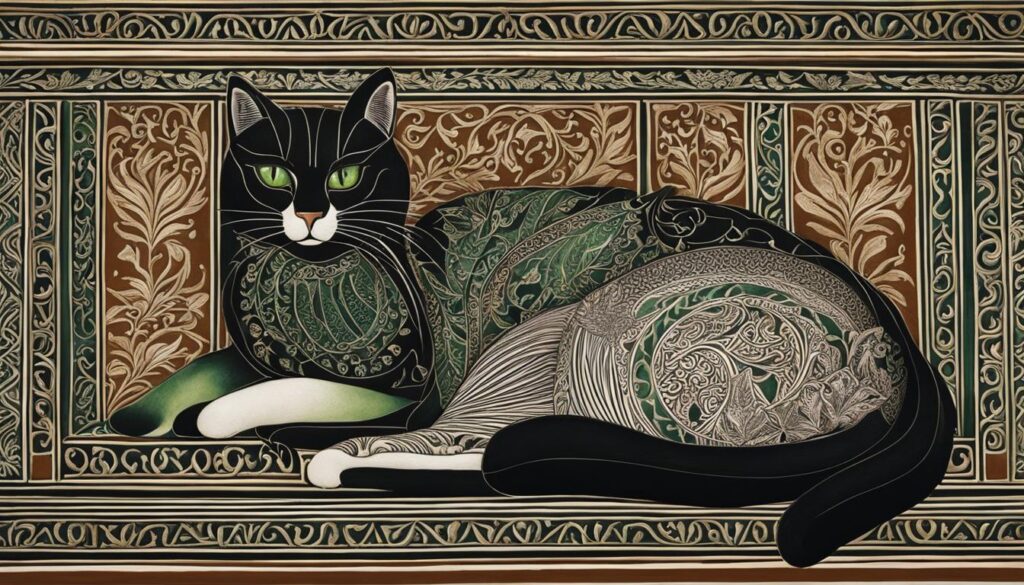
Cats in Medieval Tapestries
Medieval tapestries provide a fascinating glimpse into the artistic representations of cats during the Middle Ages. These intricate woven textiles not only adorned the walls of castles and manor houses but also served as a means of storytelling and conveying cultural beliefs. Cats, often depicted in a realistic and lifelike manner, played a significant role in the symbolism and narrative of these tapestries.
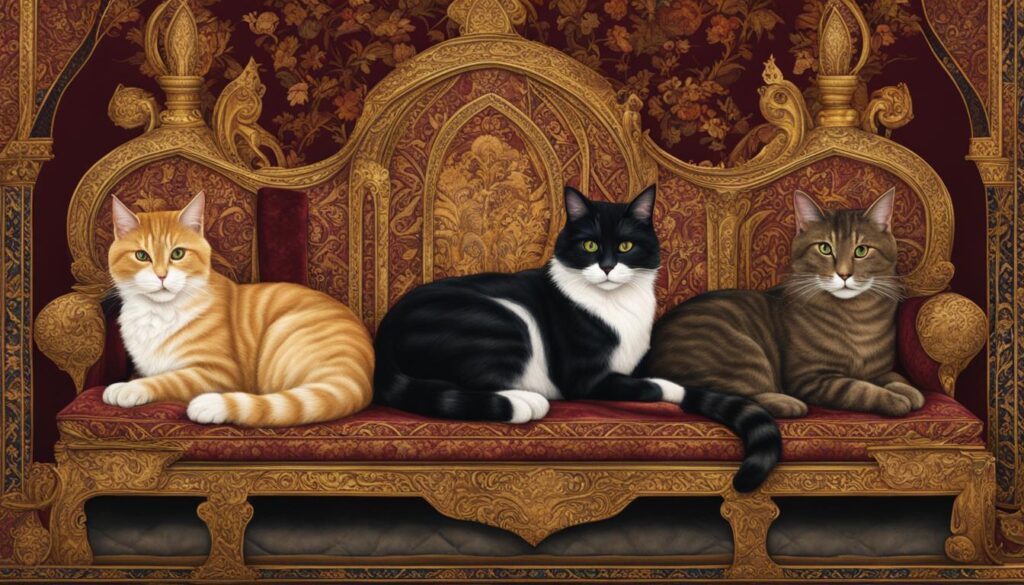
The presence of cats in medieval tapestries can be attributed to their association with various qualities and virtues. Cats were often depicted as symbols of independence, agility, and elegance. Their portrayal in tapestries served to represent traits such as cunningness, grace, or even as protectors against evil forces.
The Role of Cats in Medieval Tapestry Themes
Cats in medieval tapestries were not merely decorative elements but held a significant place within the overarching themes of these artworks. They were often featured in hunting scenes, symbolizing the prowess and skill of the hunters. Additionally, cats were sometimes shown alongside noble figures or in royal settings, signifying their importance and connection to the aristocracy.
The inclusion of cats in medieval tapestries also reflected the cultural context of the time. Cats were commonly found in households, particularly in monasteries and castles, where they served as companions and guardians against vermin. Their presence in tapestries mirrored their significance in daily life and highlighted their role in maintaining the hygiene and well-being of the inhabitants.
| Tapestry Theme | Symbolism of Cats |
|---|---|
| Hunting Scenes | Representation of agility and skill |
| Noble Figures | Symbol of status and connection to the aristocracy |
| Domestic Settings | Guardianship and role in maintaining hygiene |
Medieval tapestries provide us with a rich visual narrative of the role of cats in society and their symbolism during that time. These artworks not only showcase the artist’s skill and creativity but also offer valuable insights into the cultural beliefs and values of the medieval period.
Cats as Art Subjects in Different Cultures
Cats have been a popular subject in art across various cultures throughout history. From prehistoric cave paintings to modern-day artworks, these enigmatic creatures have captivated the imaginations of artists, resulting in a diverse range of artistic styles and interpretations. Let’s explore some remarkable examples of cats as art subjects in different cultures.
Ancient Egypt: Guardians and Deities
Ancient Egyptian art is renowned for its rich depictions of cats. In this civilization, cats were revered as sacred animals, venerated for their protective qualities. They were often depicted alongside gods and goddesses, such as the feline-headed goddess Bastet. These artistic representations showcased the Egyptians’ deep admiration for cats and their belief in their divine powers.
Medieval Japan: Symbolism and Elegance
In medieval Japan, cats were celebrated for their grace and elegance. Artists of the time captured the beauty of these creatures in various art forms, including paintings and woodblock prints. Cats were often depicted alongside geishas, emphasizing their association with sophistication and femininity. These artworks reflected the Japanese appreciation for the aesthetic qualities embodied by cats.
| Art Form | Description |
|---|---|
| Ukiyo-e | A popular form of woodblock prints, often featuring cats in playful or contemplative poses. |
| Nihonga | A traditional Japanese painting style that incorporated cats as symbolic elements. |
| Sumi-e | A type of ink wash painting where cats were portrayed with minimalistic brushstrokes, emphasizing their simplicity and elegance. |
Modern Western Art: Mystery and Intrigue
In modern Western art, cats continue to inspire artists with their enigmatic nature. From famous paintings by artists like Édouard Manet and Pierre-Auguste Renoir to contemporary works, cats have been a recurring motif. These artworks often convey a sense of mystery and independence, reflecting the allure that cats hold for many people.
“The cat is a creature of most subtle and refined perception, but he is himself deceived in the subjects of his pride.” – Sir Walter Scott
As we can see, cats have been art subjects in different cultures throughout history, symbolizing various qualities and holding diverse meanings. Their representation in art not only showcases the cultural beliefs and values of a particular society but also highlights the timeless fascination people have for these mysterious and captivating animals.
Conclusion
As I conclude my exploration of cats in ancient art, I am left in awe of the significance these enigmatic creatures have held throughout history. From the sacred depictions in Egyptian art to the subtle appearances in Greek and Roman sculptures, cats have consistently captured the imagination of artists and viewers alike.
The ancient art and artifacts featuring cats serve as a window into the cultural beliefs and reverence for these animals. Whether they symbolized protection, fertility, or cunningness, cats played a unique and cherished role in the ancient world.
Even as time progressed and artistic styles evolved, cats continued to be immortalized in various forms of art, including the intricate tapestries of the medieval period. Their presence in different cultures and artistic interpretations only reinforces the enduring fascination with these captivating creatures.
Indeed, the cats of ancient art have left an indelible mark on human society. They are a testament to the enduring bond between humans and animals, and a reminder of the mysteries and beauty that surround us. As we continue to appreciate and celebrate cats in our modern world, let us not forget their ancient counterparts who continue to inspire and amaze us through the timeless medium of art.
FAQ
What are some examples of ancient civilizations that depicted cats in their art?
Ancient civilizations like Egypt, Greece, and Rome featured cats in their artistic works.
How were cats depicted in Egyptian art?
Cats were regarded as sacred animals in ancient Egypt and were often shown in tomb paintings and sculptures. They were associated with goddesses like Bastet and symbolized protection and fertility.
Did cats play a role in Greek and Roman art as well?
While not as prevalent as in Egyptian art, cats made appearances in sculptures and other artworks in ancient Greece and Rome. They were sometimes seen as cunning and protective creatures.
Were cats featured in medieval tapestries?
Yes, cats were often included as part of the overall design in medieval tapestries, reflecting their presence in daily life and their cultural importance during that time.
Have cats been depicted in art throughout history?
Yes, cats have been subjects of art from prehistoric cave paintings to modern-day artworks, showcasing their enduring influence and the fascination with these enigmatic creatures.
What insights do artistic depictions of cats in ancient civilizations provide?
The artistic depictions of cats in ancient civilizations offer valuable insights into the cultural significance and reverence for these animals, highlighting their impact on human society throughout history.

